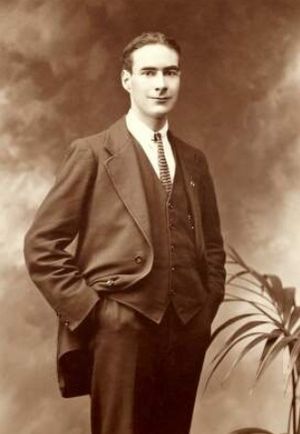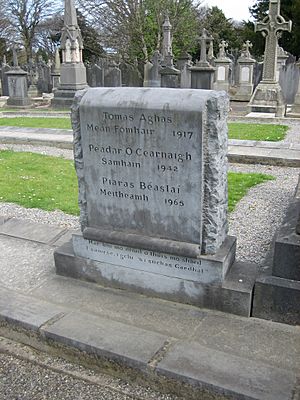Piaras Béaslaí facts for kids
Quick facts for kids
Piaras Béaslaí
|
|
|---|---|
 |
|
| Teachta Dála | |
| In office May 1921 – August 1923 |
|
| Constituency | Kerry–Limerick West |
| In office December 1918 – May 1921 |
|
| Constituency | Kerry East |
| Personal details | |
| Born |
Percy Frederick Beazley
15 February 1881 Liverpool, England |
| Died | 22 June 1965 (aged 84) Dublin, Ireland |
| Resting place | Glasnevin Cemetery, Dublin, Ireland |
| Nationality | Irish |
| Education | St Francis Xavier's College, Liverpool |
| Occupation |
|
Piaras Béaslaí (born Percy Frederick Beazley; 15 February 1881 – 22 June 1965) was an important Irish writer, playwright, and translator. He was also a strong supporter of the Irish language. Piaras was a member of the Irish Republican Brotherhood, a secret group working for Irish independence. He bravely fought in the Easter Rising in 1916. Later, he became a politician, serving as a member of Dáil Éireann, the Irish parliament.
Contents
Early Life and Learning Irish
Piaras Béaslaí was born Percy Frederick Beazley in Liverpool, England, on 15 February 1881. His parents, Patrick Langford Beazley and Nannie Hickey, were Irish Catholics. His father was a newspaper editor for many years. His mother was from County Limerick.
When Piaras was young, he spent summer holidays in Ireland near Kenmare, County Kerry. There, he started learning the Irish language from his uncle. He went to St Xavier’s Jesuit College in Liverpool. He became very good at Irish, even by the age of 17.
His Writings and Plays
After college, Piaras was encouraged to write Irish poetry. He followed his father into journalism, first working for a local newspaper. In 1906, he moved to Dublin and became a freelance writer. He wrote for several Irish newspapers, including the Irish Independent. He even wrote a daily column in Irish for the Freeman's Journal.
Piaras loved Irish-language drama. He started writing his own plays and adapting others from different languages. One of his early works was Eachtra Pheadair Schlemiel (1909), translated from German.
He continued to write poetry, like the collection “Bealtaine 1916” agus Dánta Eile (1920). He also wrote short stories. Between 1913 and 1939, he wrote many plays, including Cliuche Cartaí (1920) and An Bhean Chródha (1931). He also wrote two books about his friend, the famous Irish leader Michael Collins. These books were Michael Collins and the Making of a New Ireland (1926) and Michael Collins: Soldier and Statesman (1937).
His writings often focused on the Irish language movement and Ireland's fight for independence. He wrote for newspapers like the Standard and The Kerryman. In his later life, he wrote a popular section called ‘A Veteran Remembers’ for the Irish Independent.
In 1928, Piaras won a gold medal at the Tailteann Literary Awards for his writing. When he moved to Ireland, he began using the Irish form of his name, Piaras Béaslaí.
Role in the 1916 Easter Rising
Piaras Béaslaí was a founding member of the Irish Volunteers in 1913. This group aimed to protect Ireland's rights. In January 1916, he worked as a messenger for the revolutionary leader Seán Mac Diarmada.
During the Easter Rising in 1916, Piaras was a deputy commander. He was in charge of the 1st Dublin Battalion. He later shared his experiences in an audio recording from 1958. He described the rebels gathering and marching to the Four Courts building in Dublin. They built barricades to defend their position. The Four Courts became his main station during the fighting.
Piaras remembered seeing a green flag with a gold harp, which was a symbol of Ireland. He was in direct charge of the Four Courts area. At one point, he ordered a complete blackout to make it harder for the British soldiers. He said "things were going badly for the English soldiers." He described the event as "a weird experience," with streets lit by fires in the darkness.
He recalled the intense firing and how it suddenly stopped on Friday. When he woke up, he received P.H. Pearse's order to surrender. The rebels were taken to Richmond barracks. Piaras then spent fifteen months in English prisons. He was held in Portland and Lewes prisons. After his release, Michael Collins asked him to edit An tOglach, the Irish Volunteer newspaper. This greatly improved communication among the volunteers.
Becoming a Politician
Piaras Béaslaí later became the director of publicity for the Irish Republican Army. In the 1918 Irish general election, he was elected as a Sinn Féin Member of Parliament (MP) for Kerry East.
Sinn Féin MPs refused to go to the British Parliament. Instead, they met in Dublin in January 1919 to form their own revolutionary parliament, Dáil Éireann. Piaras was important for translating the Dáil's democratic program. He read it aloud at the very first meeting.
He was a member of the Sinn Féin party for five years. He represented Kerry East in the First Dáil from 1919 to 1921. In the 1921 Irish elections, he was re-elected without opposition to the Second Dáil. He became a Teachta Dála (TD) for Kerry–Limerick West.
After the Anglo-Irish Treaty was signed, Piaras was re-elected again without opposition in 1922. He was a pro-Treaty Sinn Féin candidate and became a member of the Third Dáil. In 1922, he traveled to the USA to explain the Treaty to Irish-American supporters. He did not run in the 1923 election.
Piaras Béaslaí and Con Collins are special because they were elected in three Irish general elections without any other candidates running against them.
Love for the Irish Language
Piaras Béaslaí dedicated a lot of his time to the Gaelic League. This organization worked to promote the Irish language and culture. In the Keating branch of the league in Ireland, Piaras became interested in the Irish Republican Brotherhood (IRB). Cathal Brugha, another member, asked him to join the IRB.
It was at the Keating branch that Piaras met Michael Collins. Piaras even introduced Collins to his cousin, Elizabeth Mernin, who was also a branch member. Piaras also helped start An Fáinne, a group for Irish speakers. Members promised to speak only Irish among themselves and wore a special badge. This showed his deep commitment to the language.
His love for Irish also allowed him to explore other interests. He wrote for Banba, an Irish journal published by the Gaelic League. He also formed a group of men called "Na hAisteoirí" to perform Irish-language theatre.
Death
Piaras Béaslaí passed away on 22 June 1965, at the age of 84. He was not married. He was buried in Glasnevin Cemetery in Dublin after a special church service.


